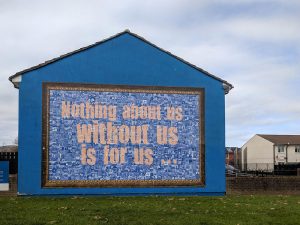“Everything runs to excess; every good quality is noxious if unmixed.”
—Ralph Waldo Emerson
The chair of the symphony’s finance committee presented financial projections indicating that a $171,000 deficit was likely by year’s end. Noting a six percent (or $50,000) endowment draw, another board member argued that the deficit was really closer to $220,000. At this point, the board chair abruptly interrupted, saying:
“Let me sum it up the way I see it: We did a terrible job of planning and made some bad decisions. That’s certainly no way to run a business by any managerial standards, and we won’t do it again. But that’s in the past. There’s no sense whipping ourselves. We’ll have a deficit this year; we need to take this as a learning experience and move on. The people to point fingers at are no longer here. The main message we need to take away is that this was a terrible financial year and we won’t let it happen again.”
The chair concluded, insisting, “We’re here to support and promote music. To that end I would like to invite Lou up here to talk to us about reed-making and the bassoon.”
Ironically, this same board had initiated termination proceedings against the previous executive director for mismanaging the organization’s funds. One might have expected that, given past experience, the board would be encouraged to question financial matters. This clearly was not the case. Instead, the chair strongly asserted his opinion that the past was past, sending the message that drawing on prior experience for guidance on a current problem was both unnecessary and a diversion from the board’s true mission.
The meeting ended after the 15-minute bassoon presentation—with no further discussion of the deficit.
We know many executive directors who would describe the board we just mentioned as a dream come true. Focused on fundraising and mission, willing to allow the executive to manage the day-to-day—what more could a hardworking, competent executive director want? But when an organization has just been handed a lesson about the problems a lack of prudent fiscal monitoring can produce, one might well question the chair’s decision to downplay the board’s concern about budget management.
In general, the flip side of any extreme strength or emphasis, whether personal or organizational, often is a weakness. So it is with boards, which raises the question: How might we correct for this very natural phenomenon?
We want in this article to acknowledge that there is more than one way to run a good organization and more than one way to be a highly functional board.[1] But organizations do tend to organize themselves around particular emphases, as if those emphases were clear, constant value sets. In fact, most sets of emphases should shift a bit over time. We propose that individual boards need to consciously choose different areas of emphasis under different circumstances based on four factors:
1. The organization’s values and purpose (this is one the more constant values sets, although it too may shift),
2. The organization’s stage of development,
3. The current organizational action agenda, and
4. The role and strengths of the staff.
Further, we would suggest that no matter what the board’s emphasis might be at any particular time, it is the job of the board chair to make sure the board is aware of it and understands the need for balance, so that no one realm of good governance falls off the radar screen for so long that it becomes hard to pick back up as an actionable emphasis at the right time.
To discuss this further, we will use an approach to understanding organizational performance called the Competing Values Framework.[2] This approach is used more generally to examine managerial and organizational performance but here is overlaid on the function of governance.
The Competing Values Framework of organizational effectiveness is structured around three dimensions reflecting the apparently competing and contradictory beliefs people hold regarding how organizational performance might best be attained:
- Organizational structure: Is there more of an emphasis on stability and control, or alternatively on flexibility and change?
- Organizational focus: Is there more of an emphasis on internal, person- and task-centered or on the external environment?
- Temporal focus: Are criteria for performance evaluation keyed primarily to organizational processes (means) or to program outcomes (ends)?
If you take the two opposing emphases in the realms of organizational structure and organizational focus and then consider the third competing dimension, time, you end up with a basic conceptual framework that provides four simple models that, depending on our values and what we believe to be important or less important in the running of an organization, lead (down different paths) to organizational effectiveness. These models are titled: Internal Process, Rational Goal, Open Systems, and Human Relations (see Competing Values Framework figure).
This framework makes explicit the expectation that organizations and boards often struggle with various messages about what they should be and do—and thus face competing and often conflicting demands.
The Open Systems Model emphasizes the importance of staying abreast of and fully adaptable to changes in the external environment–with innovation and adaptation (as means) and external legitimacy and acquisition of resources (as ends). This emphasis is built on the basic assumption that continuous research, adaptation and innovation lead to the acquisition of external legitimacy and essential resources and that this is a primary consideration for the board.
If the board sees itself as emphasizing this realm, it takes a strong role in developing the organization’s vision and spanning boundaries with the intention of enhancing the fit between the organization and its external environment. The roles associated with this model are innovator and broker/boundary spanner.
In the innovator role the board is supportive, encouraging and tolerant of uncertainty and risk. It may involve itself in helping to identify new directions, to articulate unmet needs and to respond to new opportunities and challenges.
In the broker role the board serves as a liaison to important constituencies; it ensures that the agency has adequate resources to meet organizational purposes, and enhances the organization’s public image. As boundary spanner, the board helps to develop critical “exchange relationships” with external constituencies.
To make the leadership functions in this quadrant work, the board is very likely acting in an open systems way with the staff, pairing with them and engaging in common committees that likely also engage other stakeholders.
The Rational Goal Model emphasizes stability and control by focusing attention on goal attainment and planning (as the means) and productivity and accomplishment (as ends). This emphasis is built on the basic assumption that clarity of direction will lead to productive outcomes and that this is a primary consideration for the board. The roles associated with this quadrant are director and producer.
In the director role the board takes a lead in ensuring that expectations are clear and are keyed to the mission. It may be actively involved in formulating the mission and/or in ensuring that decision-making and other activities fit the mission, thereby providing policy-level direction for the organization. The board also helps to develop long-term strategic plans with an emphasis on goals and objectives and specific definitions of roles and tasks.
In the producer role the board focuses on organizational accomplishment. It expects clear goal-setting and requires reports on progress.
To be seen as effective in this model, board members model these expectations through an ongoing critical examination of how well the board is:
- Discharging its own responsibilities,
- Following through on promises and obligations, and
- Accepting responsibility for the overall focus and practical viability of the organization.
Sign up for our free newsletters
Subscribe to NPQ's newsletters to have our top stories delivered directly to your inbox.
By signing up, you agree to our privacy policy and terms of use, and to receive messages from NPQ and our partners.
The Internal Process Model emphasizes standards of practice—with documentation and information management (as means) and stability and control (as ends). This emphasis is built on the basic assumption that routine and standardization lead to stability and that this is a primary consideration for the board.
The leadership roles are those of coordinator and monitor.
In the coordinator role the board oversees the structure and the flow of the system. It may involve itself in ensuring that information is exchanged and work is coordinated properly within a system. If it is very hands-on, it may try to manage the flow of external information, passing on only the information it deems useful in advancing the work of the organization. Committees may be used to help sort out the flow of information and facilitate the completion of specific tasks.
In the monitor role the board focuses on stability and control; it makes sure organizational action is aligned with budgetary restrictions and mission considerations. It does this by exercising its fiduciary responsibility to provide effective oversight, particularly with regard to budgeting, programming and planning decisions. This expectation is reinforced by legal responsibility to ensure that the organization acts in ways consistent with its mission and purpose. The implicit assumption is that without board oversight, managers might behave in self-interested ways that are not consistent with the organization’s mission. (See Miller, Nonprofit Quarterly, Fall 2002.)
Effectiveness according to this model means the board itself must adhere to predictable norms—monitoring this in an observable way—and must coordinate its work on standard-setting with the staff.
The Human Relations Model is focused on the development of individuals and the smooth functioning of the group processes that integrate those individuals into a whole, well-focused organization. It differentiates between the management of individual resources (as means) and smooth functioning of group processes (as ends). This emphasis is built on the basic assumption that involvement results in commitment and that commitment results in excellence—and that this is a primary consideration for the board.
The Human Relations Model emphasizes the board’s responsibility to serve in a mentor and facilitator capacity.
As a mentor the board has an obligation to orient new members and make training and skill development available for the board and staff. In addition to strengthening its own processes and performance, the board has a responsibility to build organizational capacity by providing direction, guidance and support to the chief executive while also recognizing and respecting the expertise that the chief executive brings to the daily operation of the organization.
In its facilitator role the board emphasizes group process, fostering openness, cohesiveness, and a shared sense of purpose. It does this by encouraging teamwork. By embracing decision-making process that tolerate conflict, promote shared knowledge, and value the integration of diverse perspectives, the board builds group cohesion.
For the board to be effective within this model, it must hold itself to a high standard of dialogue, planning well to make sure processes are consistently adhered to and yet decisions are made in a timely way.
In our example above, the board was expected to generate resources for the symphony by encouraging outreach and extensive interaction with the public (brokering). However, it was also responsible for discharging a fiduciary responsibility to ensure legal compliance and accountability to its donors (monitoring).
Because these criteria, values and assumptions may be perceived as opposites in our minds, we may tend to exclude one realm of attention in favor of another or, sometimes even more destabilizing, swing on a pendulum from one extreme to another. Alternatively, we suggest that for a nonprofit board to contribute to organizational effectiveness, it must recognize the tradeoffs that occur when one set of values is embraced over another, and ensure that the emphases in each quadrant of the model are, to a reasonable extent, balanced.
You may recognize characteristics of the models laid out above in the behavior of your own board. Few boards are wholly in one model or another, if only because we are constantly made aware of other people’s expectations about board behavior. These expectations can sound as if they’re in conflict with one another because, if pursued single-mindedly and without an understanding of the need for balance, they are.
To make a long story short, too much of a good thing at the board level can hurt organizational performance. Too much stability and control can result in rigidity and an inability to adapt, just as too much adaptability can lead to a wandering away from mission. Overemphasizing the development needs of those inside the organization may rob energy from important external relationship building.
Organizations develop values streams that emerge out of a combination of organizational intentions, personalities, belief systems and experiences. Sometimes when an organization starts off with one strongly held value set that ends up excluding another important governance function, it will react and move to the other extreme. It’s not uncommon to hear a board tell itself its own set of cautionary tales to justify some current, apparently extreme behavior—over-cautiousness, for instance. To prevent this, it’s important for the board not only to engage in those activities that it strongly values, but also to strengthen its performance in areas where it’s uncomfortable or for which it may not currently have the requisite knowledge or skills. Because each quadrant in the competing values framework has an extreme opposite with contrasting emphasis, a competing values approach can help boards target their areas of weakness.
Organizations need different things at different times, but even when we understand that we must try to move from one emphasis to another, we may find it difficult to do. A board that is focused on its fiduciary responsibilities and oversight of the budget may respond to a weakness in fundraising by more extensively monitoring the organization’s programming and planning decisions.
However, in keeping with the competing values approach, the imperative for such a board is to embrace processes more closely associated with the Open Systems Model. Admittedly, the transition to processes that are more external and instrumental and that encourage flexibility and creativity may prove difficult for a board that values a more data-driven, goal-centered, efficient, or accountable approach to governance. Nevertheless, attention to the weaknesses made explicit by embracing a competing values perspective can help the board identify specific activities and processes that are likely to strengthen performance and, thereby, contribute to organizational effectiveness.
The board, of course, is always in some partnership with the staff. This takes many different forms in different organizations. It will be important for the board to ensure that between the board and the staff there is both alignment and a balance of emphases. If the board is being deployed to develop external relationships, the staff may wish to make sure that internal processes and protocols are standardized or vice versa.
The competing values approach helps the board understand its obligation to continually assess whether a particular activity or course of action overvalues some dimension of effectiveness while failing to appreciate another.
We hope it will prove useful as a tool for understanding the paradoxical and multidimensional nature of board and organizational performance and the connection between the two. Moreover, the Competing Values Framework can help boards learn to value each of the dimensions of effectiveness, recognizing that each dimension contains attributes essential to effective performance.
- This article is based, in part, on the paper “A Competing Values Approach to Understanding Board Leadership,” presented at the 2002 conference of the Association for Research on Nonprofit and Voluntary Action, Montreal, Quebec, Nov. 14-16.
- Robert E. Quinn. 1988. Beyond Rational Management. San Francisco: Jossey-Bass.
Sue Faerman is professor of public administration and organizational studies and dean of undergraduate studies State University New York at Albany. She has done extensive consulting on management and organization development with organizations in the public, nonprofit and private sectors.
Judith L. Miller is an assistant professor of political science in the college of arts and sciences at Ohio University. She is also a principal in Carman and Miller, a consulting group providing services to public and nonprofit organizations.









